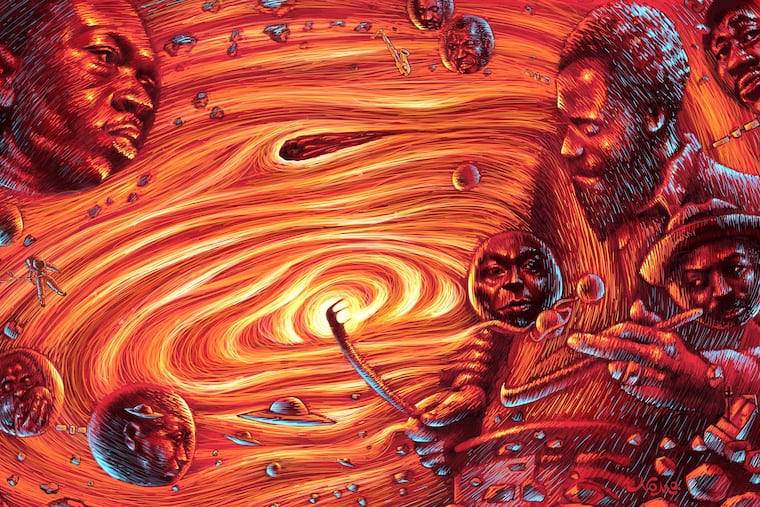Philadelphia Jazz Project launches first graphic novel
The Philadelphia Jazz Project is finding new ways to get younger audiences passionate about jazz.

There’s a well-known theory in physics called the “observer effect,” which says that we change something just by studying it. Maybe that’s what happened to jazz. Somewhere along the way, arguably the most exciting and unique American art form became so dissected and theorized about that it left the clubs for the scholarly realm.
It’s OK. This sort of happens to everything cool, from Shakespeare to Rick & Morty.
The trick is keeping jazz vital in both places, the museums and the neighborhoods, the head and the heart. In this city, that’s Homer Jackson’s job. As the founder and director of the nonprofit Philadelphia Jazz Project, he’s made it his mission to capture the ears and imaginations of a new generation. He knows what he’s up against.
“Right now, I think the overall community doesn’t know very much about Philadelphia jazz,” says Jackson. Since founding the PJP eight years ago, he’s tried to win new audiences through concerts, parties, you name it.
And now he’s trying a new tactic: graphic novels, starting with Philadelphia Jazz Stories Illustrated: Volume One, a handsome, colorful tome built on interviews and personal essays about the city’s jazz scene. This isn’t a history book, focused on theory, dates, and names. Instead, it zeroes in on the emotional impact of the music and what it felt like to be in the room when the masters played long lost clubs like Pep’s on South Broad or The Earle at 11th and Market.
This weekend at the Barnes Foundation, there will be performances by saxophonist Larry Price and guitarist Jeff Scull followed by a panel discussion about the book, with African American studies scholar Dianne Turner, art director Eric Battle, and illustrator Denise Erickson.
‘It starts to get mystic’
“If you ask a jazz fan about an experience that they had with a performance, or seeing a musician, it gets into mythic, almost science fiction [territory],” says Jackson. “Because there's no simple words to describe how you felt and what you experienced. It all starts to get into hyperbole, you know what I mean? It starts to get mystic.”
So many of the book’s central subjects — Sun Ra, John Coltrane, Byard Lancaster, etc. — lend themselves nicely to swirling collages of colors and instruments. Rufus Harley and his bagpipe look right at home among the stars on page 14. Ghosts come pouring out of McCoy Tyner’s piano on page 75.
Local experts — including Turner, radio producer Steve Rowland and Jackson himself — spoke with dozens of musicians including Odean Pope, Bootsie Barnes, Suzanne Burgess, Billy Paul, Rashied Ali, and Farid Barron for the book’s many stories and vignettes.
Some people told their own stories; others related fly-on-the-wall tales about their fellow musicians: Grover Washington, Bootsie Barnes, Benny Golson, Charlie Parker, Suzanne Burgess, Billie Holiday, and on and on. (Even Wilt Chamberlain makes an appearance, but I won’t spoil it for you here.)
The stories, Jackson says, are a reminder of jazz’s proud history as a social phenomenon, something people would listen to on dates and dance to at clubs.
Jackson has tried to get young people excited about jazz before, with varying degrees of success.
A few years ago, the PJP threw a big Halloween party on Temple’s campus. The event featured a killer band led by trombonist Steve Tirpak, a DJ, horror movie clips on a big screen and cheap entrance fee of five bucks. Everyone who came had a great time, but hardly anyone came. “We were shocked. We were two blocks away from two dormitories and we couldn’t get people out,” recalls Jackson.
At another event, the PJP added hip-hop to the mix, but found that people weren’t interested unless there was some star power on the bill. “I found that really interesting. I thought that young people from Philadelphia would be interested in other talented young people from Philadelphia. But I found that that wasn’t necessarily the case. They were moved by people who have a reputation.”
Just booking skilled players isn’t enough.
“Skill is something valuable — and it gives people a clue about how much energy and time one has put in — but it's important to tell a story that people can relate to and speak to them in some kind of way. Move them emotionally.”
Using art to break through
Perhaps Philadelphia Jazz Stories, with its fast-paced storytelling and vibrant art will make some headway with the kids. Many of its contributing artists come from the comic book world, including Jerry Pinkney, Jamar Nicholas, Akinseye Brown, and Eric Battle — who also curated the art for the project.
The book was a five-year labor of love for Jackson, Battle, and designer Lynn Washington, but it’s called Volume One for a reason: They want to keep the series going. But first, they have to find their audience.
“I think museums [and] all kinds of entities and organizations who are trying to reach young people have that same challenge. You've got to come very correct. You've got to come very correct,” says Jackson.
“I don’t blame young people at all because it’s not their job to find you, it’s your job to find them.”